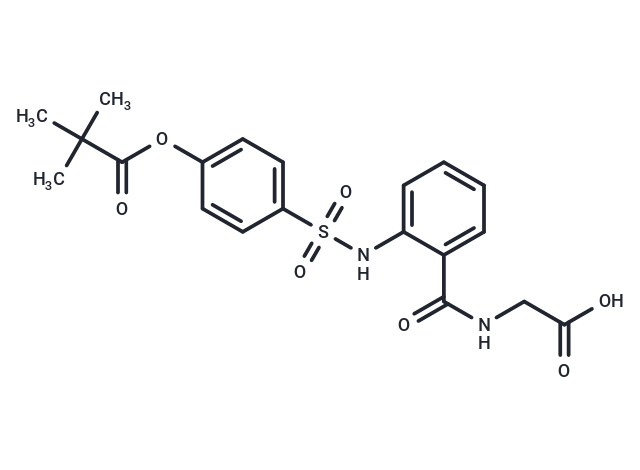Shopping Cart
- Remove All
 Your shopping cart is currently empty
Your shopping cart is currently empty

Sivelestat (ONO5046) is a potent and selective inhibitor of neutrophil elastase with IC50 of 44 nM.

| Pack Size | Price | Availability | Quantity |
|---|---|---|---|
| 5 mg | $42 | In Stock | |
| 10 mg | $61 | In Stock | |
| 25 mg | $110 | In Stock | |
| 50 mg | $210 | In Stock | |
| 100 mg | $315 | In Stock | |
| 200 mg | $523 | In Stock | |
| 500 mg | $837 | In Stock | |
| 1 mL x 10 mM (in DMSO) | $68 | In Stock |
| Description | Sivelestat (ONO5046) is a potent and selective inhibitor of neutrophil elastase with IC50 of 44 nM. |
| Targets&IC50 | Neutrophil elastase:44 nM. |
| In vitro | Sivelestat suppresses iNOS gene expression in proinflammatory cytokine-stimulated hepatocytes. Sivelestat reduces the levels of inflammatory mediators by inhibiting NF-kB. It suppresses the growth of gastric cancer cells by inhibiting the release of TGF-α stimulated by NE. |
| In vivo | Administration of sivelestat attenuates pulmonary fibrosis after acute lung injury in mice. Sivelestat could attenuate sepsis-related kidney injury in rats. It blocks GAPDH/Siah1 which is a novel signaling pathway during the progression of spinal cord injury. |
| Cell Research | TMK-1 Gastric carcinoma cells are seeded into 96-well culture plates (5 ×103 cells/well) in RPMI containing 7% FBS, 2.0 mM L-glutamine, and 1% nonessential amino acids. Following 24-h incubation in RPMI-1640 medium with 5% FBS, the cells are incubated for 24, 48 or 72 h at 37°C in a humidified atmosphere of 5% CO2 with varied concentrations (0.1–1.0 μg/mL) of NE, or with varied concentrations (0.1–1000 μg/mL) of sivelestat or with concentrations (10 and 100 ng/mL) of anti-TGF-α antibody in the presence of 1 μg/mL NE. After incubation, 10 μL of MTT solution (5 mg/mL) is added to each well and the plates are then incubated for 3 h at 37°C. The growth medium is then replaced with 150 μL of dimethyl sulfoxide (Wako) per well and the absorbance at 540 nm is measured. |
| Animal Research | Animal Models: Male Sprague-Dawley rats. Formulation: Saline. Dosages: 50 or 100 mg/kg. Administration: i.p. |
| Alias | ONO5046, LY544349, EI546 |
| Molecular Weight | 434.46 |
| Formula | C20H22N2O7S |
| Cas No. | 127373-66-4 |
| Smiles | CC(C)(C)C(=O)Oc1ccc(cc1)S(=O)(=O)Nc1ccccc1C(=O)NCC(O)=O |
| Relative Density. | 1.369 g/cm3 |
| Storage | Powder: -20°C for 3 years | In solvent: -80°C for 1 year | Shipping with blue ice. | |||||||||||||||||||||||||||||||||||
| Solubility Information | Ethanol: 80 mg/mL (184.14 mM), Sonication is recommended. H2O: < 1 mg/mL (insoluble or slightly soluble) DMSO: 45 mg/mL (103.58 mM), Sonication is recommended. | |||||||||||||||||||||||||||||||||||
Solution Preparation Table | ||||||||||||||||||||||||||||||||||||
DMSO/Ethanol
| ||||||||||||||||||||||||||||||||||||

Copyright © 2015-2025 TargetMol Chemicals Inc. All Rights Reserved.